Arson Campaign
In July 1912, Emmeline Pankhurst gave permission for Christabel Pankhurst, to launch a secret arson campaign. She knew that she was likely to be arrested and so she decided to move to Paris. Attempts were made by suffragettes to burn down the houses of two members of the government who opposed women having the vote. These attempts failed but soon afterwards, a house being built for David Lloyd George, the Chancellor of the Exchequer, was badly damaged by suffragettes. (1)
Annie Kenney was put in charge of the WSPU in London. Every week Kenney travelled to France to receive Christabel's latest orders. Fran Abrams has pointed out: "It was the start of a cloak-and-dagger existence that lasted for more than two years. Each Friday, heavily disguised, Annie would take the boat-train via La Havre. Sundays were devoted to work but on Saturdays the two would walk along the Seine or visit the Bois de Boulogne. Annie took instructions from Christabel on every little point - which organiser should be placed where, circular letters, fund-raising, lobbying MPs... During the week Annie worked all day at the union's Clement's Inn headquarters, then met militants at her flat at midnight to discuss illegal actions. Christabel had ordered an escalation of militancy, including the burning of empty houses, and it fell to Annie to organise these raids. She did not enjoy this work, nor did she agree with it. She did it because Christabel asked her to, she said later." (2)
Christabel Pankhurst was aware that after the House of Lords had rejected the proposed 1831 Reform Act, a mob had attempted to burn down Nottingham Castle. She therefore asked Sylvia Pankhurst to carry out a similar attack. Sylvia later wrote: "The idea of doing a stealthy deed of destruction was repugnant... Though I knew she did not consider it so, I had the unhappy sense of having been asked to do something morally wrong. I replied that I should be willing to lead a torchlight procession to the castle, to fling my torch at it, and to call the others to do the same, as a symbolic act." Christabel was unimpressed and rejected the idea. (3)
At a meeting in France, Christabel Pankhurst told Frederick Pethick-Lawrence and Emmeline Pethick-Lawrence about the proposed arson campaign. When they objected, Christabel arranged for them to be expelled from the the organisation. Emmeline later recalled in her autobiography, My Part in a Changing World (1938): "My husband and I were not prepared to accept this decision as final. We felt that Christabel, who had lived for so many years with us in closest intimacy, could not be party to it. But when we met again to go further into the question… Christabel made it quite clear that she had no further use for us." (4)
As Fern Riddell has pointed out: "From 1912 to 1914, Christabel Pankhurst orchestrated a nationwide bombing and arson campaign the likes of which Britain had never seen before and hasn't experienced since. Hundreds of attacks by either bombs or fire, carried out by women using codenames and aliases, destroyed timber yards, cotton mills, railway stations, MPs' homes, mansions, racecourses, sporting pavilions, churches, glasshouses, even Edinburgh's Royal Observatory. Chemical attacks on postmen, postboxes, golfing greens and even the prime minister - whenever a suffragette could get close enough - left victims with terrible burns and sorely irritated eyes and throats, and destroyed precious correspondence." (5)
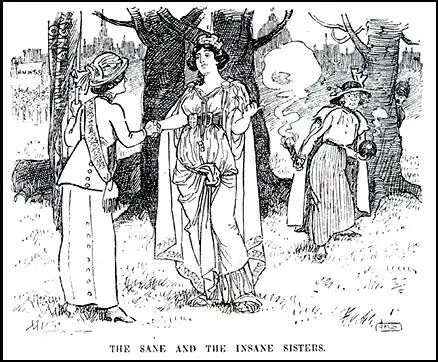
which are so different from those of your poor, misguided sister who I can't tolerate at all."
Joseph Morewood Staniforth, Western Mail (1913)
The WSPU used a secret group called Young Hot Bloods to carry out these acts. No married women were eligible for membership. The existence of the group remained a closely guarded secret until May 1913, when it was uncovered by the conspiracy trial of eight members of the suffragette leadership, including Flora Drummond, Annie Kenney and Rachel Barrett. (6) During the trial, Barrett said: "When we hear of a bomb being thrown we say 'Thank God for that'. If we have any qualms of conscience, it is not because of things that happen, but because of things that have been left undone." (7)
One of the first arsonists was Mary Richardson. She later recalled the first time she set fire to a building: "I took the things from her and went on to the mansion. The putty of one of the ground-floor windows was old and broke away easily, and I had soon knocked out a large pane of the glass. When I climbed inside into the blackness it was a horrible moment. The place was frighteningly strange and pitch dark, smelling of damp and decay... A ghastly fear took possession of me; and, when my face wiped against a cobweb, I was momentarily stiff with fright. But I knew how to lay a fire - I had built many a camp fire in my young days - and that part of the work was simple and quickly done. I poured the inflammable liquid over everything; then I made a long fuse of twisted cotton wool, soaking that too as I unwound it and slowly made my way back to the window at which I had entered." (8)
Annie Kenney was charged with "incitement to riot" in April 1913. She was found guilty at the Old Bailey and was sentenced to eighteen months in Maidstone Prison. Her deputy, Grace Roe, now became head of operations in London. She immediately went on hunger strike and became the first suffragette to be released under the provisions of the Cat and Mouse Act. Kenney went into hiding until she was caught once again and returned to prison. That summer she escaped to France during a respite and went to live with Christabel Pankhurst in Deauville. (9)
Christabel Pankhurst remained convinced that escalating violence would eventually win the parliamentary vote for women since it would create, she believed, an intolerable situation for politicians. In early January 1914, she asked Sylvia to travel to Paris where she told her that her East London Federation must be separate from the WSPU since it was allied to the socialist movement. (10)
Sylvia was also criticised for speaking on the same platform as the Labour Party MP, George Lansbury. Christabel told her: "You have your own ideas. We do not want that; we want all our women to take their instructions and walk in step like an army!" Sylvia later recalled: "Too tired, too ill to argue, I made no reply. I was oppressed by a sense of tragedy, grieved by her ruthlessness. Her glorification of autocracy seemed to me remote from the struggle we were waging." (11)
Christabel also told her sister that she must withdraw support from the Labour Party. She had now decided that the WSPU should not form any alliance with male politicians. Christabel wrote in The Suffragette: "For Suffragists to put their faith in any men's party, whatever it may call itself, is recklessly to disregard the lessons of the past forty years… The truth is that women must work out their own salvation. Men will not do it for them". (12)
In January 1913, Emmeline Pankhurst made a speech where she stated that it was now clear that Herbert Asquith had no intention to introduce legislation that would give women the vote. She now declared war on the government and took full responsibility for all acts of militancy. "Over the next eighteen months, the WSPU was increasingly driven underground as it engaged in destruction of property, including setting fire to pillar boxes, raising false fire alarms, arson and bombing, attacking art treasures, large-scale window smashing campaigns, the cutting of telegraph and telephone wires, and damaging golf courses". (13)
The women responsible for these arson attacks were often caught and once in prison they went on hunger-strike. Determined to avoid these women becoming martyrs, the government introduced the Prisoner's Temporary Discharge of Ill Health Act. Suffragettes were now allowed to go on hunger strike but as soon as they became ill they were released. Once the women had recovered, the police re-arrested them and returned them to prison where they completed their sentences. This successful means of dealing with hunger strikes became known as the Cat and Mouse Act. (14)
On 24th February 1913, Emmeline Pankhurst was arrested for procuring and inciting persons to commit offences contrary to the Malicious Injuries to Property Act 1861. The Times reported: "Mrs Pankhurst, who conducted her own defence, was found guilty, with a strong recommendation to mercy, and Mr Justice Lush sentenced her to three years' penal servitude. She had previously declared her intention to resist strenuously the prison treatment until she was released. A scene of uproar followed the passing of the sentence." (15)
After going nine days without eating, they released her for fifteen days so she could recover her health. "They sent me away, sitting bolt upright in a cab, unmindful of the fact that I was in a dangerous condition of weakness, having lost two stone in weight and suffered seriously from irregularities of heart action." On 26th May, 1916, when Emmeline Pankhurst attempted to attend a meeting, she was arrested and returned to prison. (16)
During this period Kitty Marion was the leading figure in the WSPU arson campaign and she was responsible for setting fire to Levetleigh House at St Leonards (April 1913), the Grandstand at Hurst Park racecourse (June 1913) and various houses in Liverpool (August, 1913) and Manchester (November, 1913). These incidents resulted in a series of further terms of imprisonment during which force-feeding occurred followed by release under the Cat & Mouse Act. It has been calculated that Marion endured 200 force-feedings in prison while on hunger strike. (17)
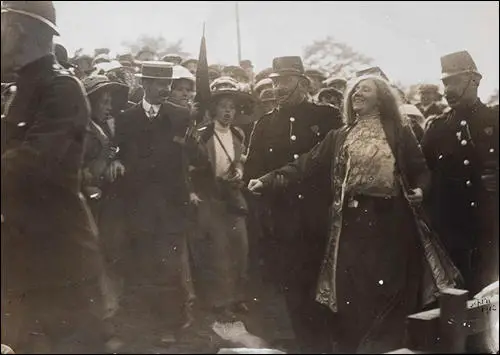
On 9th April 1913, two bombs were left on the Waterloo to Kingston line, placed on trains going in opposite directions. One bomb was found at Battersea on the train coming from Kingston in a previously crowded third-class carriage. A railway porter had seen smoke slowly creeping from under a seat. He discovered a white wooden box containing a tin canister in which sixteen live gun cartridges, wired together and joined up with a small double battery, had been attached to a tube of explosive. Packed in among the cartridges were lumps of jagged metal, bullets and scraps of lead. Four hours later, as a train from Waterloo pulled into Kingston, the third-class carriage exploded and was quickly consumed by fire. Luckily the carriage was empty and no one was injured. (18)
Miriam Pratt, a member of the WSPU, did not share these concerns, and on 17th May 1913, she set fire to an empty building attached to the Balfour Biological Laboratory for Women, in Storey's Way, Cambridge, with paraffin-soaked cloth. (19) The building was erected in 1884 on for the use of women studying science at Newnham and Girton. The laboratory enabled women to learn about anatomy, dissection, microbiology, zoology, chemical compounds and physics. (20)
Fern Riddell has pointed out why Miriam selected this target: "But what good was a university laboratory, and a university education, if women were refused the right to be awarded their degrees? Although universities permitted women to attend courses and take exams, they were not allowed to graduate, and there was little opportunity for them to use the knowledge they acquired in the world outside the protected college atmosphere. Perhaps it was the unbearable unfairness of this inequality that removed any qualms Miriam and her companions might have felt that night, as they broke and set a fire that consumed a considerable amount of the adjoining building before the alarm was raised." (21)
When the police examined the scene of the fire they found suffrage literature. This was done to show the authorities that the crime had been committed by the WSPU in protest against the government's decision not to give the vote to women. Frank Meeres has pointed out that two buildings in Cambridge had been targeted, "first a new house being built for a Mrs Spencer of Castle Street, then a new genetics laboratory. Suffrage leaflets were found in both. A lady's gold watch was discovered outside the window of the laboratory which had been used to get in.... Blood had been found where the arsonist had cut herself while scraping out the putty around the window; Miriam had a corresponding wound." (22)
Miriam's uncle, William Ward, was involved in the investigation. He suspected the watch belonged to Miriam. When confronted by Ward about the matter she admitted that she had carried out the attack. As a result she was arrested and taken to the local police court. The Cambridge Independent Press reported that Miriam Pratt was a "tall, pretty girl", who was "dressed in a light blue corduroy coat, a blue cloth skirt, and black velvet toque trimmed with light blue ribbon." (23)
Miriam Pratt was remanded for eight days before being granted bail. The sureties of £200 was raised by a friend, Dorothy Jewson, a member of the WSPU and the Independent Labour Party. Miriam was suspended from her job at St Paul's National School in Norwich. On 18th July, Miriam attended a protest demonstration held on Norwich Market Place against the Cat and Mouse Act. (24)
Miriam Pratt appeared at Cambridge Assizes in October. She chose to represent herself. The main evidence against her came from her uncle. Miriam asked the judge: "Is it legal for the witness to give evidence of a statement he alleges to have obtained from me not having first cautioned me, he being a police officer?" The judge replied: "That does not disqualify him. He was not acting as a police officer." Miriam asked her uncle: "Don't you think it was your duty as a police officer to caution me?" He admitted "it was my duty, but I was speaking to you as a father would do, and I omitted to caution you." (25)
In her final statement to the court, Miriam admitted her guilt: "I ask you to look again at what has been done and see in it not wilful and malicious damage, but a protest against a callous Government, indifferent to reasoned argument and the best interests of the country. A protest carried to extreme because no other means would avail... show by your verdict today that to fight in the cause of human freedom and human betterment is to do no wrong." (26)
Miriam was sentenced to eighteen months' hard labour and sent to Holloway Prison. Soon after her arrival surveillance photographs of Miriam were taken from a van parked in the prison exercise yard. The images were compiled into photographic lists of key suspects, used to try and identify and arrest Suffragettes before they could commit militant acts. (27)
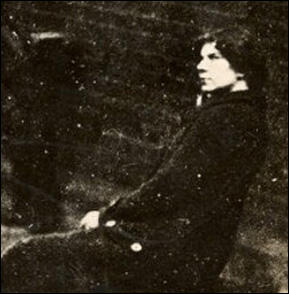
Miriam Pratt immediately went on hunger strike. The damage force-feeding had inflicted on Miriam was swift and brutal. The Suffragette reported: "Lord, help and save Miriam Pratt and all those being tortured in prison for conscience sake." (28) Doctors were worried about the impact this was having on her heart and released her and ordered three months' bed rest. (29)
Miriam's statement in court was printed as a leaflet and distributed by members of the Women's Social and Political Union and the Independent Labour Party. This campaign, organized by Dorothy Jewson, included giving out leaflets inside Norwich Cathedral. (30) Miriam was never recalled to prison because of the controversy created by the Cat and Mouse Act and the falling numbers of women willing to go to prison. According to Martin Pugh, the WSPU was a spent force with very few active members. (31)
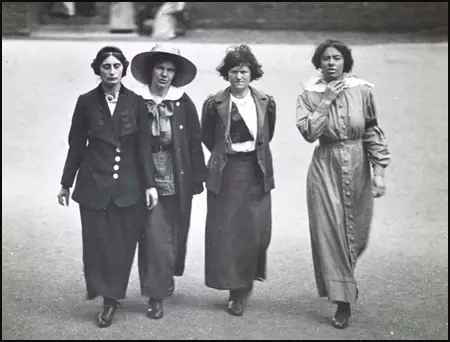
exercising in the yard of Holloway prison (February 1913)
Although Elizabeth Robins and Octavia Wilberforce disapproved of Kitty Marion's arson campaign they used their 15th century farmhouse at Backsettown, near Henfield, as a hospital and helped her recover from her various spells in prison and the physical effects of going on hunger strike. On 31st May 1914, with the help of Mary Leigh, escaped to Paris.
Lilian Lenton was another member of the WSPU who played an important role in the arson campaign. Along with Olive Wharry she embarked on a series of terrorist acts. They were arrested on 19th February 1913, soon after setting fire to the tea pavilion in Kew Gardens. In court it was reported: "The constables gave chase, and just before they caught them each of the women who had separated was seen to throw away a portmanteau. At the station the women gave the names of Lilian Lenton and Olive Wharry. In one of the bags which the women threw away were found a hammer, a saw, a bundle to tow, strongly redolent of paraffin and some paper smelling strongly of tar. The other bag was empty, but it had evidently contained inflammables." While in custody, Lenton went on hunger strike and was forcibly fed. She was quickly released from prison when she became seriously ill after food entered her lungs. The Morning Post (8th March, 1913)
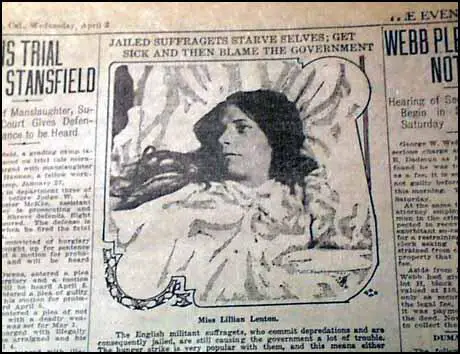
On 7th March 1913 Olive Wharry was found guilty and sentenced to eighteen months. Elizabeth Crawford, the author of The Suffragette Movement (1999): "She was released on 8th April after having been on hunger strike for 32 days, apparently without the prison authorities noticing. His usual weight was 7st 11lbs; when released she weighed 5st 9lbs."
After Lilian Lenton recovered she managed to evade recapture until arrested in June 1913 in Doncaster and charged with setting fire to an unoccupied house at Balby. She was held in custody at Armley Prison in Leeds. She immediately went on hunger-strike and was released after a few days under the Cat & Mouse Act. The following month she escaped to France in a private yacht.
According to Elizabeth Crawford, the author of The Suffragette Movement (1999): "Lilian Lenton has stated that her aim was to burn two buildings a week, in order to create such a condition in the country that it would prove impossible to govern without the consent of the governed." Lenton was soon back in England setting fire to buildings but in October 1913 she was arrested at Paddington Station. Once again she went on hunger-strike and was forcibly fed, but once again she was released when she became seriously ill.
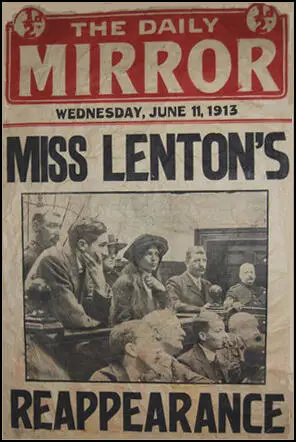
Lilian Lenton was released on licence on 15th October. She escaped from the nursing home and was arrested on 22nd December 1913 and charged with setting fire to a house in Cheltenham. After another hunger-and-thirst strike, she was released on 25th December to the care of Mrs Impey in King's Norton. Once again she escaped and evaded the police until early May 1914 when she was arrested in Birkenhead. She was only in prison for a few days before she was released under the Cat & Mouse Act.
Some leaders of the WSPU such as Emmeline Pethick-Lawrence, disagreed with this arson campaign. When Pethick-Lawrence objected, she was expelled from the organisation. Others like Elizabeth Robins, Jane Brailsford, Laura Ainsworth, Eveline Haverfield and Louisa Garrett Anderson showed their disapproval by ceasing to be active in the WSPU and Hertha Ayrton, Lilias Ashworth Hallett, Janie Allan and Elizabeth Garrett Anderson stopped providing much needed funds for the organization. Sylvia Pankhurst also made her final break with the WSPU and concentrated her efforts on helping the Labour Party build up its support in London.
Colonel Linley Blathwayt and Emily Blathwayt also cut off funds to the WSPU. In June 1913 a house had been burned down close to Eagle House. Under pressure from her parents, Mary Blathwayt resigned from the WSPU. In her diary she wrote: "I have written to Grace Tollemache (secretary for Bath) and to the secretary of the Women's Social and Political Union to say that I want to give up being a member of the W.S.P.U. and not giving any reason. Her mother wrote in her diary: "I am glad to say Mary is writing to resign membership with the W.S.P.U. Now they have begun burning houses in the neighbourhood I feel more than ever ashamed to be connected with them."
Primary Sources
(1) Sylvia Pankhurst The Suffrage Movement (1931)
In December 1911 and March 1912, Emily Wilding Davison and Nurse Pitfield had committed spectacular arson on their own initiative, both doing their deeds openly and suffering arrest and punishment. In July 1912, secret arson began to be organised under the direction of Christabel Pankhurst. Women, most of them very young, toiled through the night across unfamiliar country, carrying heavy cases of petrol and paraffin. Sometimes they failed, sometimes succeeded in setting fire to an untenanted building - all the better if it were the residence of a notability - or a church, or other place of historic interest. Occasionally they were caught and convicted, usually they escaped.
(2) Mary Richardson, Laugh a Defiance (1953)
I took the things from her and went on to the mansion. The putty of one of the ground-floor windows was old and broke away easily, and I had soon knocked out a large pane of the glass. When I climbed inside into the blackness it was a horrible moment. The place was frighteningly strange and pitch dark, smelling of damp and decay. I had to feel my way along, step by step, encumbered, as I was, by the three heavy parcels I had slung round my neck. After much groping I reached the hallway and knew I was near my objective. This was a cupboard under the main staircase.
To get the cupboard door to open was no easy thing. The hinges were rusted and they creaked and groaned ominously. A ghastly fear took possession of me; and, when my face wiped against a cobweb, I was momentarily stiff with fright. But I knew how to lay a fire - I had built many a camp fire in my young days-and that part of the work was simple and quickly done. I poured the inflammable liquid over everything; then I made a long fuse of twisted cotton wool, soaking that too as I unwound it and slowly made my way back to the window at which I had entered.
I climbed outside before setting a light to the fuse. For a moment I stood and watched the tiny flame run a few feet; then I hurried off to find the gap in the thorn hedge. When I did find it and crawled through, Millicent had fled.
I bumped into Millicent as she was hurrying back to find me.
"I'm terribly sorry," she explained. "I just couldn't...."She stopped short and looked back behind us; I looked back, also. The red glow had grown into a huge red mushroom.
"We must get away quickly," I gasped. "We'd better separate. If we're alone it'll look less suspicious; and it'll be easier for one to get a lift in a market-gardener's cart going to Covent Garden. I'll go this way; you make your way back to the road."
Millicent clutched at my arm and burst into tears. "Oh no. No! No! Please let me come with you. I'd never find my way alone. Oh please, I feel so frightened."
"Very well," I said. "But it's a risk. And we'll have to hurry."
We went as fast as we could; but we were both groggy from fatigue and the mental strain of the whole, ugly business. After a while we heard the clanging of the bells on the fire-engines. We staggered on and made renewed efforts to get as far away as we could. For a long time we seemed to be walking along outside a high wall.
"It must be a gasworks," I said.
We kept on walking beside the wall. Millicent was unable to answer me or even to say yes or no. The fog was becoming denser; and we were still outside the wall. I began to feel we were condemned to walk beside it for ever in punishment for our sins. But at last we came to what seemed to be a residential quarter. There were some small houses in long rows. I sighed with relief as I turned the corner; then I cried, "Look!"
"What?"
"That blue light," I said.
"Blue light?" said Millicent in a puzzled way. "What is it? What...."
But she was unable to finish her question before two tall figures loomed out of the fog and were upon us.
"Aren't you two out a bit late?" one of the policemen said.
"Yes. Yes - we missed the last bus back to town," I stammered.
A should say you did... said the man. "Just step across the road. We've been looking for you for the past hour."
We seemed to be the cause of some mild jubilation in the police station. Probably this was because we had been so speedily arrested, but it was the fog that had beaten us, and not the vigilance of the law.
(3) Christabel Pankhurst described the arson campaign in her book Unshackled (1959)
Many militants had been restive for some time, considering that it would be more dignified to anticipate the sorry outcome of the Government's now broken pledge than await it passively. As leaders, we had felt bound to restrain this eagerness, but now there was no reason for delay. The ingenuity and the pertinacity of the Suffragette guerillists were extraordinary. Never a soul was hurt, but the struggle continued.
Golf greens suffered on one occasion by the carving on the turf of 'Votes Before Sport' and 'No Votes, No Golf'! The editor of Golfing complained on the plea that "golfers are not usually very keen politicians." "Perhaps they will be now," said the Suffragettes.
The damage done to property was more spectacular than serious. Museums began to be closed, here and there, with preventive caution, to the vexation of American visitors. Mr. Lloyd George's house at Walton Heath paid the price of its owner's deed.
(4) Mary Richardson, Laugh a Defiance (1953)
Law and its application reflected public opinion. Values were stressed from the financial point of view and not the human. I felt I must make my protest from the financial point of view, therefore, as well as letting it be seen as a symbolic act. I had to draw the parallel between the public's indifference to Mrs. Pankhurst's slow destruction and the destruction of some financially valuable object.
A painting came to my mind. Yes, yes - the Venus Velasquez had painted, hanging in the National Gallery. It was highly prized for its worth in cash. If I could damage it, I reasoned, I could draw my parallel. The fact that I had disliked the painting would make it easier for me to do what was in my mind.
I made my plans carefully and sent a copy of them to Christabel, setting out my reasons for such an action. The days, while I waited for her reply, seemed endless. But at last the message came, "Carry out your plan."
But it was always easier to make a plan than to carry it out. As the day approached when I should have to act I grew nervous. It was as though the task I had set myself was bigger than I could accomplish. I hesitated, hedged with myself, tried to say that someone else would be better able to do such a job than I. It will be difficult for anyone who has not known service in a great cause to understand my suffering...
I left the house without saying goodbye to any of the others. My axe was fixed lip the left sleeve of my jacket and held in position by a chain of safety-pins, the last pin only needing a touch to release it.
I walked rapidly and made my way by the side streets through Soho to Leicester Square, and then round to the back of the Gallery and so on to its front entrance.
It was a "free" day and there were many people going in. I kept with the crowds at first. On the first landing of the staircase where the stairs separated on the left and on the right I stopped and, from where I stood, I could see the Venus hanging on the north wall of the room on the right-hand side. Before the painting, guarding it, sat two broad-shouldered detectives. They were on the red plush seat in the centre of the room with their backs to me and seemed to be staring straight in front of them.
I turned away and wandered into the room on the left. This and several others I passed through, studying some of the paintings until, half an hour afterward, I found myself at the doorway of the room where the Venus was. To control my feelings of agitation I took out the sketch book I had brought with me and tried to make a drawing. Still with the open pad in my hand I entered the room and chose to stand in the far corner of it to continue my sketch. I found I was staring at an almond-eyed madonna whose beauty it was far beyond my powers to reproduce. Her smile, however, impressed itself sufficiently upon my senses to bring me a certain calmness of mind.
The two detectives were still between me and the Venus. I decided at last to leave the room and to wait for a while longer.
I studied the landscapes and watched the people who were passing; and, as I watched them, I felt I would have given anything to have been one of them. I spent an hour like this, in utter misery. It was getting near to mid-day, I knew. Chiding myself for having wasted two precious hours I went back to the Venus room. It looked peculiarly empty. There was a ladder lying against one of the walls, left there by some workmen who had been repairing a skylight. I had to pass in front of the detectives, who were still sitting on the seat, to approach the Velasquez painting. When I was near enough to it I saw that thick and possibly unbreakable glass had been put over it, no doubt as a protection. As I turned I saw there was a Gallery attendant standing in the far doorway. There were now three I must avoid.
I began to sketch again-this time I was a little nearer my objective. As twelve o'clock struck, one of the detectives rose from the seat and walked out of the room. The second detective, realising, I suppose, that it was lunch-time and he could relax, sat back, crossed his legs, and opened a newspaper.
That presented me with my opportunity - which I was quick to seize. The newspaper held before the man's eyes would hide me for a moment. I dashed up to the painting. My first blow with the axe merely broke the protective glass. But, Of course, it did more than that, for the detective rose with his newspaper still in his hand and walked round the red plush seat, staring up at the skylight which was being repaired. The sound of the glass breaking also attracted the attention of the attendant at the door who, in his frantic efforts to reach me, slipped on the highly polished floor and fell face downward. And so I was given time to get in a further four blows with my axe before I was, in turn, attacked.
It must all have happened very quickly; but to this day I can remember distinctly every detail of what happened...
Two Baedeker guide books, truly aimed by German tourists, came cracking against the back of my neck. By this time, too, the detective, having decided that the breaking glass had no connection with the skylight, sprang on me and dragged the axe from my hand. As it out of the very walls angry people seemed to appear round me. I was dragged this way and that; but, as on other occasions, the fury of the crowd helped me. In the ensuing commotion we were all mixed together in a tight bunch. No one knew who should or should not be attacked. More than one innocent woman must have received a blow meant for me.

